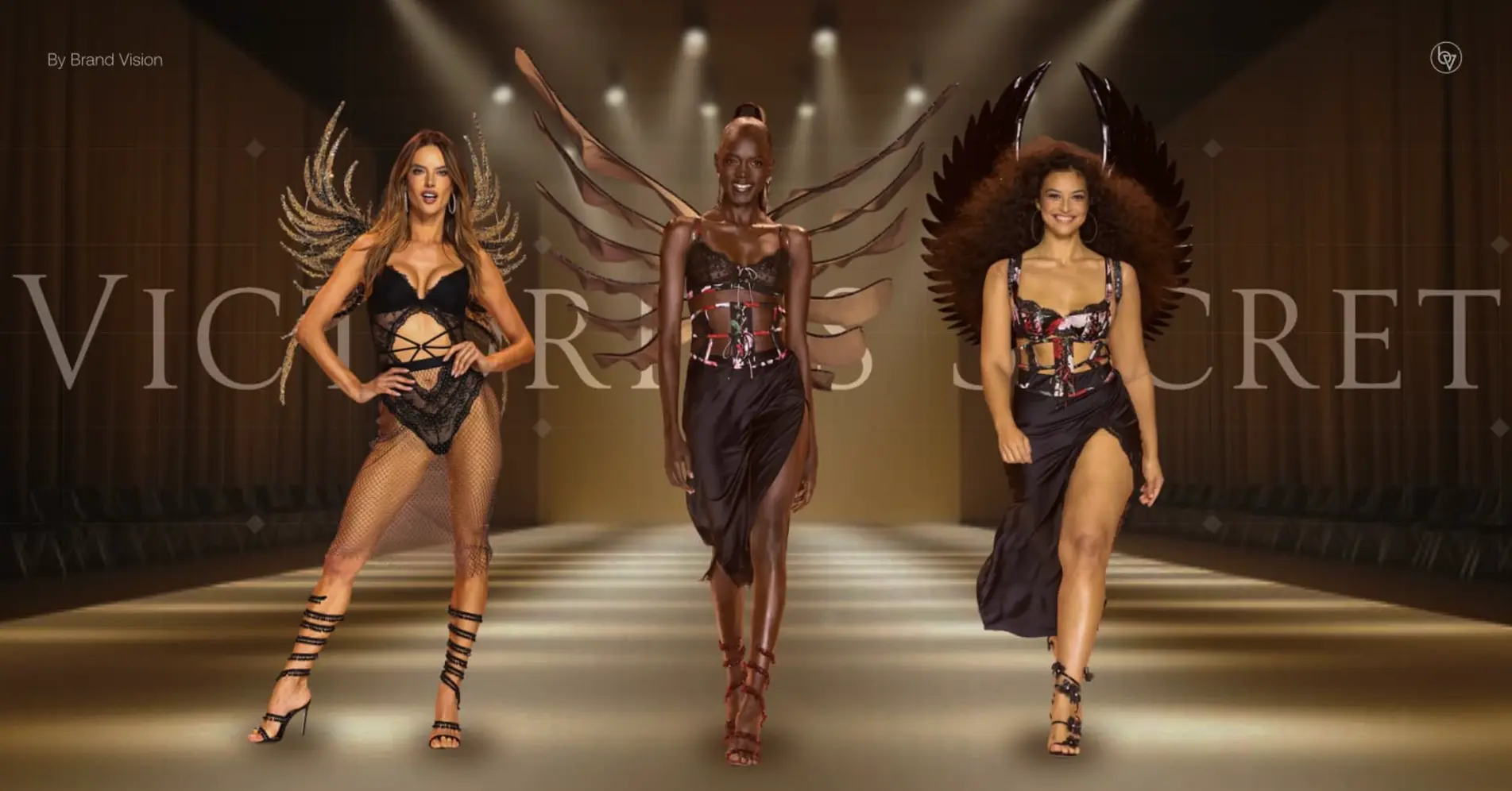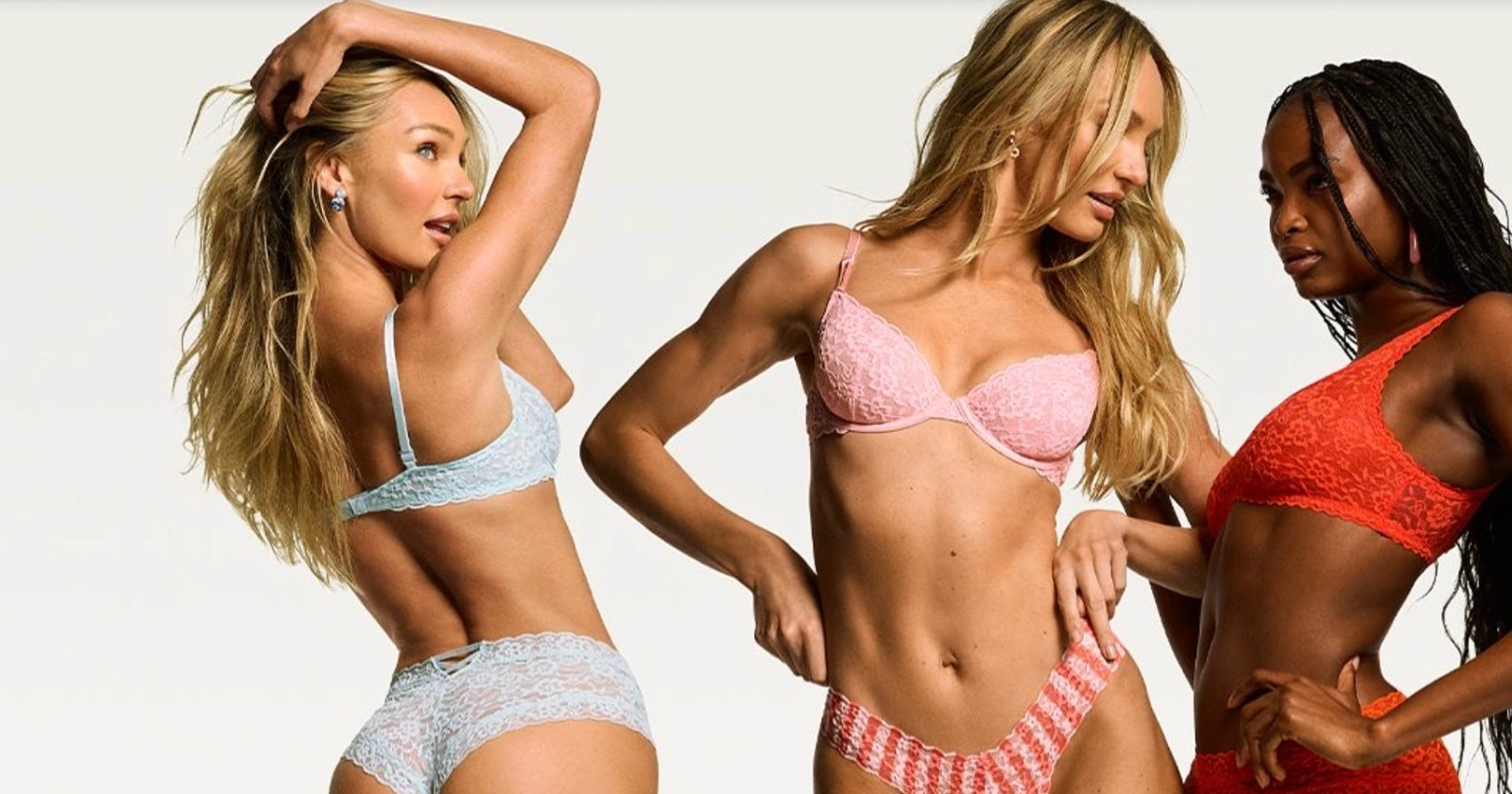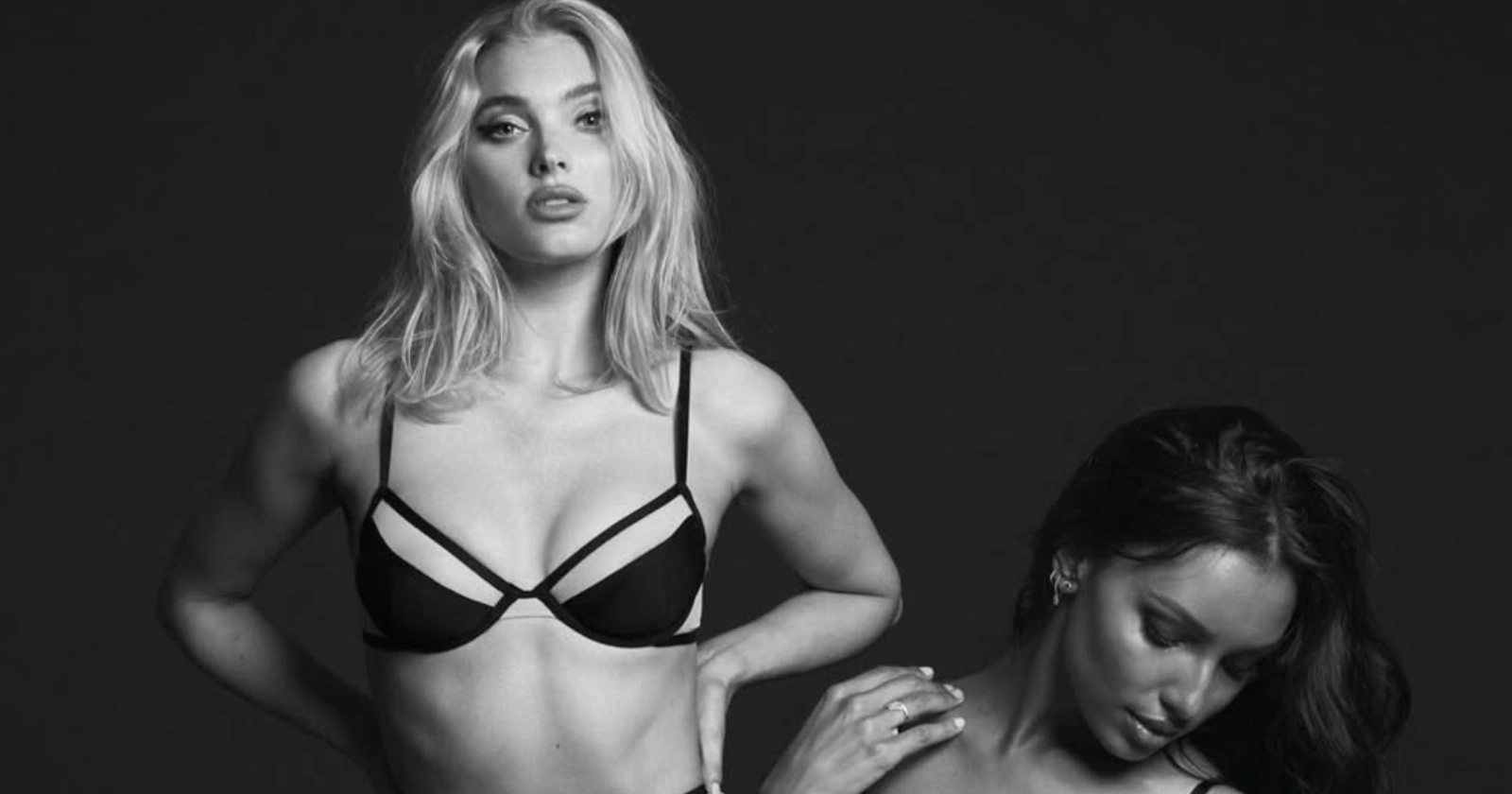Victoria’s Secret Marketing Strategy 2025: Rebrand, Campaigns, Influencers and the Fashion Show
Updated on
Published on

It’s nearly impossible to walk through a mall—or scroll past social media ads—without coming across some aspect of Victoria's Secret marketing in 2025. Over the years, the lingerie powerhouse has leveraged runway spectacles, celebrity endorsements, and an unmistakable pink-and-black aesthetic to become one of the most recognizable names in fashion retail. Yet in the last few seasons, consumers have seen a seismic shift in how Victoria's Secret branding is pitched—less about glam fantasy, more about inclusive reality. So, how did this brand grow from racy catalog roots into a multi-billion-dollar company, and what does the future hold for marketing Victoria's Secret?
Victoria’s Secret Quarter 2 2025 Highlights (Most Recent Report)
- Net sales $1.459B (up 3% year over year), above guidance of $1.380B to $1.410B; comparable sales up 4%.
- Gross margin rate expanded despite tariff headwinds, helped by tighter inventory and a more disciplined promotional approach.
- GAAP results: operating income $41M (vs $62M last year), EPS $0.20 (vs $0.40 last year).
- Adjusted results: operating income $55M (guidance was $15M to $35M), net income $27M, EPS $0.33 (guidance was $0.00 to $0.15).
- Channel and geography: North America stores +3.1%, direct –5.5%, international +21.8%; quarter-end store count 1,376.
- Full-year 2025 sales outlook raised to $6.33B to $6.41B (from $6.2B to $6.3B); adjusted operating income reiterated at $270M to $320M.
- Tariff headwind now ~ $100M for FY2025, up $50M versus prior outlook.
- Q3 2025 guidance: net sales $1.39B to $1.42B (vs $1.347B last year); adjusted operating loss $35M to $55M; adjusted EPS –$0.55 to –$0.75.
- Management notes momentum across Victoria’s Secret and PINK, in stores and online, with July and early August accelerating due to product newness and updated brand storytelling; first full quarter under refreshed leadership. Victoria's Secret & Co.
Iconic Victoria's Secret 2025 Campaigns
Victoria’s Secret has leaned into fashion-forward collabs to refresh its point of view, and two standouts nail very different moods. The LoveShackFancy capsule leans romantic and vintage—think soft pastels, micro-florals, bows, and lace across lingerie and sleep pieces that feel giftable and collectible. It’s dreamy, nostalgic, and very “cottage-core,” designed to turn basics into keepsakes. The Frankies Bikinis link-up swings the other way: sun-kissed, flirty swim with buttery fabrics, curve-loving cuts, and beach-to-street sets that tap the coastal-cool crowd. Together, they signal VS’s strategy—pair core fit expertise with cult aesthetics to reach new shoppers without losing the brand’s signature polish. Victoria's Secret also announced the Victoria's Secret Fashion Show 2025 will be on October 15th!
The Early Magic: Glamour, Fantasy, and the “Angel” Era
Roy Raymond established Victoria's Secret in San Francisco in 1977. Since then, the company has grown internationally, with over a thousand stores in the US and a solid foundation in markets throughout Asia, the Pacific, and Europe. In 2022, the value of women's underwear and nightgowns was approximately $88.32 billion. As the leading lingerie retailer in the US, Victoria's Secret has influenced the market with its creative marketing campaigns targeting a variety of demographics. Victoria's Secret is able to successfully market its wares to affluent young professionals and style-conscious individuals by using segmentation, targeting, and positioning strategies.
For decades, Victoria's Secret's marketing strategy revolved around glitzy high fashion shows and supermodel “Angels,” feeding a mass media phenomenon that created huge brand awareness. The annual Victoria’s Secret Fashion Show (complete with bejeweled Fantasy Bras and star-studded performances) was once a cultural fixture. Legendary campaigns used bombshell silhouettes, dramatic visuals, and carefully orchestrated color palettes, forging a fantasy-driven approach that implied sophistication and exclusivity. These tactics positioned Victoria's Secret branding as aspirational for women who wanted to tap into that supermodel confidence, and it worked—sales soared as the chain opened stores internationally, saturating mainstream consumer consciousness.
Under the hood, the brand’s marketing harnessed glossy catalogs, prime-time TV commercials, and a heavy mall presence. Victoria’s Secret also extended into fragrances, lounge wear, and beauty products, pushing the notion of a “one-stop shop” for all things feminine. The brand’s color-coded store design (pinks, nudes, and black lace accents) became iconic, while the sparkly runway events and those eye-catching Angel wings remained front and center of the brand’s identity. For a while, Victoria’s Secret marketing was the perfect storm: high glamour, widespread distribution, and constant hype among celebrities.

Facing Modern Pressures: Critiques and Changing Tastes
However, the glam approach eventually ran into cultural headwinds. Shifts in consumer sentiments—around body diversity, authenticity, and female empowerment—led many to question whether marketing Victoria's Secret through impossibly thin supermodels still resonated with real women. Competitors like Aerie were championing untouched photos and inclusive sizing, while activewear brands like Lululemon embraced function over flamboyance. Meanwhile, digital-first disruptors leveraged social media to highlight body positivity or ethically made undergarments. As these trends gained momentum, critics turned a sharper eye on Victoria’s Secret Fashion Shows and the brand’s “perfect body” marketing.
By the late 2010s, Victoria's Secret's rebranding became a growing necessity. Sales began to plateau. The final blow came when the annual fashion show ratings plummeted, leading the company to cancel the TV broadcasts entirely. Although the brand tried to pivot with younger lines (like PINK) or occasional diversity-focused campaigns, consumer sentiment demanded deeper change. That was the turning point when executives recognized that Victoria's Secret branding had to adapt for the modern market, or risk irrelevance in an age of inclusivity.
Growth Strategy
Victoria's Secret & Co. announced its strategic growth plan. The company wants to make the most of its Victoria's Secret and PINK brands and strengthen its position as the world's biggest store for intimate clothing. Three important goals for the company are to strengthen the core, boost growth, and change the foundation. Brands like Aerie and Adore Me have taken the lead in this movement, embracing diversity in their marketing campaigns. So Victoria's Secret’s acquisition of the Adore Me brand provided synergistic opportunities that fueled strong international growth.
Victoria's Secret & Co. is focusing on a few key areas as part of its growth strategy to help the company grow and get customers more involved. First, the company wants to refresh its brand identity and better serve its main customers. Second, it wants to expand its product line and category so that it can meet the needs of all women's fashion tastes. Additionally, the business wants to boost its brand recognition and cultural importance by focusing on product-driven entertainment. In addition to these initiatives, Victoria's Secret wants to expand its global footprint with multi-year plans to enhance sales and profitability in existing international markets. The acquisition of the Adore Me brand is expected to drive growth further, given its tech-enabled capabilities and synergies with Victoria's Secret and PINK. The company's third-quarter financial outlook shows signs of improvement, with sales trends exceeding expectations.

4Ps of Victoria’s Secret
A. Product
Victoria's Secret sells more than just lingerie. The brand is known for having a huge selection of bras, from basic ones that you wear every day to fancy ones that make a statement. The brand is renowned for its extensive range of bras, encompassing everything from everyday essentials to luxurious pieces. Complementing its bras, Victoria’s Secret offers an extensive collection of panties, ranging from thongs and bikinis to hipsters and boyshorts. The sleepwear collection exudes elegance and sophistication, with luxurious robes, silky nightgowns, and cozy pyjama sets designed for relaxation and indulgence. Recognizing the growing demand for stylish and functional activewear, Victoria’s Secret offers a range of athletic apparel designed to inspire confidence and performance. The fragrances are renowned for their alluring scents and exquisite packaging, while the beauty products, including body lotions, body mists, and makeup, provide a luxurious sensory experience.
B. Price
Victoria’s Secret positions itself as a premium lingerie brand, offering high-quality products at price points that reflect the brand’s commitment to luxury and exclusivity. While the prices may be higher compared to some competitors, customers are willing to invest in Victoria’s Secret products for their superior quality, meticulous craftsmanship, and iconic branding.
C. Promotion
In order to reach its target audience and spread its brand message, Victoria's Secret uses a variety of marketing channels. The brand invests in high-profile advertising campaigns featuring its iconic angels and models, showcased across multiple platforms. Active engagement on social media platforms fosters a sense of community and connection with its followers. Strong email marketing keeps customers informed and engaged with the brand, while in-store events create unique shopping experiences, driving foot traffic and generating excitement.
D. Place
Victoria’s Secret strategically selects store locations to maximize visibility and accessibility for its target audience. Physical retail stores are established in high-traffic shopping malls, upscale retail districts, and prime urban areas, providing customers with a tactile shopping experience. Additionally, the brand has a strong online presence through its e-commerce platform, offering a seamless shopping experience and expanding its reach and accessibility.
Victoria's Secret Rebranding Efforts
For a long time, the company's marketing strategy was based on the male gaze, which made women seem like objects and sexualized them instead of giving them power. However, as societal norms evolved, particularly with the rise of movements promoting body positivity, inclusivity, and diversity, Victoria's Secret found itself out of step with the values of younger consumers. In response to mounting criticism and declining sales, Victoria's Secret initiated a rebranding effort aimed at portraying itself as more feminist and inclusive. This involved featuring a diverse lineup of models, including individuals from various ethnicities, body types, and backgrounds, in its marketing campaigns and fashion shows.
This transition has posed challenges as the brand seeks to appeal to a wider audience while maintaining its core brand identity. In light of Victoria's Secret's revitalization efforts, the company's "Icons" campaign featured a mix of familiar supermodels from its past, such as Gisele Bündchen and Adriana Lima, alongside newer faces like Hailey Bieber and plus-size model Paloma Elsesser. This blend of old and new aims to remind audiences of Victoria's Secret's former glory while adapting to modern values of inclusivity. Victoria's Secret's attempts to modernize its image, featuring models like Megan Rapinoe and Eileen Gu in campaigns, have faced challenges due to perceptions of the brand as exclusive and outdated. While Victoria's Secret's latest campaign features models of diversity, consumers question the authenticity of these efforts. Victoria's Secret doubled down on its female empowerment messaging with the launch of another campaign called "Undefinable," featuring celebrities like Bella Hadid, Hailey Bieber, and rising country singer Brittany Spencer. The campaign, aimed at revamping the brand's image, was showcased through immersive experiences at its flagship store in Manhattan and across major cities, as well as on social media platforms.

Challenges and Opportunities in a Changing Market
Even with progressive new moves, Victoria’s Secret branding faces a crowded marketplace. Consumers have grown used to seeing everyday bodies on brand websites, meaning the chain must consistently deliver on inclusivity or face more backlash. Younger customers also prioritize sustainability, ethical sourcing, and authenticity in marketing. The brand’s long association with high-glam runway shows remains a complicated legacy—some see it as nostalgic fun, others as out of sync with modern values.
But there’s an upside, too: the shift allows the brand to recapture consumers who left for more inclusive competitors. With a massive store network and name recognition, if Victoria's Secret marketing can fully commit to a body-positive and socially-conscious approach, it stands to maintain brand loyalty among existing fans while winning over new customers craving a reliable, inclusive underwear destination. Tools like customized bra fittings, digital try-on technology, and lounge-style store layouts could make the shopping experience more personal. On social media, the brand’s daily feed has grown more interactive, highlighting real customer stories—an approach that resonates strongly in an era of engaged marketing.
The Road Ahead: Will the Rebrand Stick?
While the brand’s rework is still in progress, the decision to pivot away from unattainable fantasy signals a new chapter in Victoria's Secret branding. The brand’s thorough transformation demands not just fresh ad campaigns, but a shift in internal culture and product development. If the chain succeeds at merging style with comfort, hype with authenticity, it may well re-establish itself among the best fast food chains in Canada—oops, mixing metaphors, but ironically, it highlights how brand repositioning can be as challenging as changing a fast-food menu midstream! Jokes aside, the real question is whether the brand’s structural changes—broader size ranges, updated imagery, staff retraining—will stick for the long haul.
Going forward, the brand’s successful reintroduction hinges on building trust. Loyal fans want to see classic elements they loved remain, but with a more progressive flair. Past critics need evidence that Victoria’s Secret marketing has evolved beyond “Angels on a catwalk.” While no brand can please everyone instantly, consistent authenticity typically wins in the end. As trends continue to shift toward “confidence, not perfection,” the chain’s newly minted ethos could help it shine in an overcrowded lingerie market.

The 2024 New York City Fashion Show
On October 15, 2024, Victoria’s Secret staged a highly anticipated return to live spectacle in the heart of New York City, unveiling its latest collection amidst a buzz of excitement and inclusive fanfare. This show embodied the brand’s reimagined focus on authenticity and body celebration—gone were the towering Angel wings in favor of real-life muses of diverse shapes and backgrounds. The event took on a fresh musical flair with rising star Tyla headlining the catwalk performance, her dynamic vocals punctuating the reveal of modern silhouettes in jewel tones and sustainable fabrics. Attendees were greeted by interactive backstage streams on social media, playful “fit-and-flair” sessions for VIP guests, and a live mural where participants scrawled messages of self-love. True to its evolving marketing Victoria's Secret style, the brand avoided a single “fantasy narrative” and instead told multiple mini-stories: from everyday lounge sets that champion comfort to avant-garde statement pieces that celebrated individuality. The result was an energized crowd, an Instagram feed brimming with inclusive content—and a living testament that Victoria's Secret rebranding is more about personal confidence than unattainable runway fantasies.
Victoria’s Secret Marketing Strategy in 2025
By 2025, Victoria’s Secret marketing strategy is a carefully balanced combination of inclusivity, digital engagement, and personalized shopping experiences—no flashy runways required. The brand now spotlights a diverse group of brand ambassadors, representing various backgrounds, ages, and sizes. With a renewed emphasis on authenticity, Victoria’s Secret branding highlights user-generated content in official campaigns: real customers post reviews and style tips on social media, while the brand reposts and celebrates fan stories. This approach signals the chain’s commitment to listening to its community. On the digital front, Victoria’s Secret's marketing relies on celebrity partnerships to spark conversation about product lines, from everyday comfort wear to limited-edition collabs. Victoria's Secret designed and made the corsets and bodysuits for Sabrina Carpenter's Short and Sweet tour in 2024. Meanwhile, the brand’s advanced loyalty program and newly refined app unify the online and in-store experience—customers can scan items in boutiques for detailed info, earn personalized discounts, and check wait times for fitting rooms, all of which fosters a sense of belonging that is central to Victoria Secret rebranding in 2025.
Parallel to these social and digital enhancements, Victoria’s Secret branding has pivoted toward a holistic focus on lifestyle and wellness, reinforcing the message that undergarments are about confidence and function, as well as style. Store designs now feature curated sections for different facets of daily life—loungewear for restful evenings, bras engineered for high-impact fitness, and eco-friendly fabrics for conscious shoppers—each backed by marketing stories that reflect authenticity. Engaging pop-up events in malls or community centers let fans experience collections firsthand, test fabrics, and learn about the chain’s sustainability projects. On social platforms, behind-the-scenes content reveals product innovation and ethical sourcing, reinforcing Victoria's Secret rebranding as genuine and transparent. Altogether, these multi-channel tactics create a synergy wherein every ad campaign, influencer post, and storefront element aligns with the notion that Victoria’s Secret marketing in 2025 is all about celebrating individual style, real-world comfort, and a modern, inclusive definition of beauty.
A New Height for the Wings of Victoria's Secret
In sum, the Victoria’s Secret marketing landscape of 2025 has blossomed into a lively, consumer-focused enterprise—one that still carries the brand’s historic allure but frames it in a more socially attuned, authentic light. Whether debuting new collections at intimate pop-ups, unveiling runway moments that champion real diversity, or spotlighting ambassadors like Tyla, the company has demonstrated its capacity to pivot. The modern marketing Victoria’s Secret playbook caters to a broader audience and harnesses digital innovation, showing that a forward-thinking fashion brand can indeed honor past glitz while evolving to reflect the values of today. Ultimately, Victoria's Secret branding now goes beyond lace and runway glam—it reaffirms beauty as an inclusive dialogue, inviting customers to feel seen, empowered, and excited to participate in the brand’s next era.
FAQ on VS in 2025
1) How did Q2 FY2025 stack up against guidance?
Net sales were $1.459B (+3% y/y) with comps +4%, and adjusted results (OI $55M, EPS $0.33) beat guidance while gross margin expanded despite tariff headwinds.
2) What drove growth across channels and regions?
North America stores rose +3.1%, international jumped +21.8%, and direct fell –5.5%; management cites product newness and refreshed storytelling lifting both Victoria’s Secret and PINK.
3) What’s the updated outlook for the rest of 2025?
Full-year sales are raised to $6.33–$6.41B with adjusted OI $270–$320M reiterated; Q3 guides $1.39–$1.42B sales and an adjusted OI loss of $35–$55M, with a tariff headwind now ~$100M for FY25.
4) What are the key marketing priorities right now?
The brand is leaning into inclusive, product-first storytelling, fast newness and fit leadership, headline collabs (LoveShackFancy, Frankies Bikinis), and the Fashion Show’s Oct 15, 2025 return.
5) How is the company protecting margins while it grows?
Tighter inventory and a more disciplined promo mix expanded gross margin, while Adore Me’s digital/test-and-learn capabilities support better fit, size coverage, and efficiency.
6) What risks matter most—and how are they being managed?
Tariffs, intense competition, and proving authenticity on inclusivity are the big ones; management points to refreshed leadership, omnichannel loyalty, and consistent product newness to offset them.







